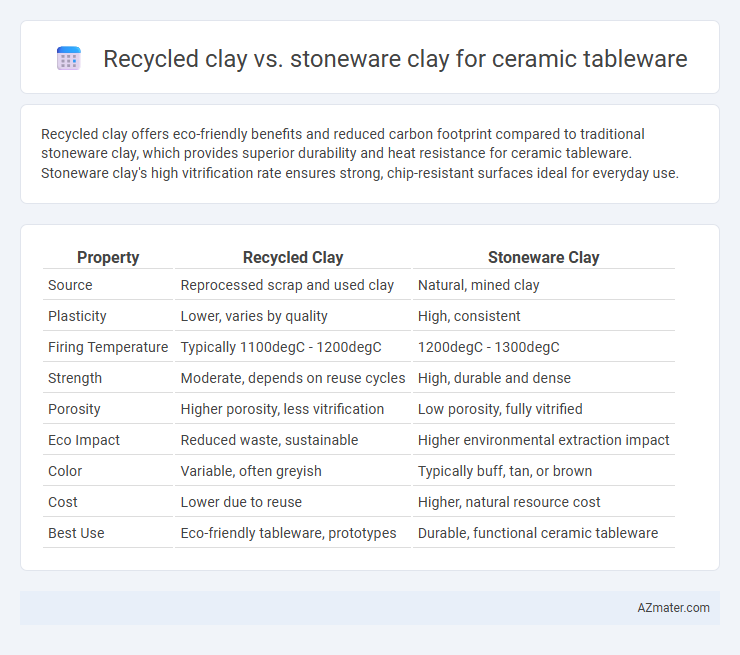Recycled clay offers eco-friendly benefits and reduced carbon footprint compared to traditional stoneware clay, which provides superior durability and heat resistance for ceramic tableware. Stoneware clay's high vitrification rate ensures strong, chip-resistant surfaces ideal for everyday use.
Table of Comparison
| Property | Recycled Clay | Stoneware Clay |
|---|---|---|
| Source | Reprocessed scrap and used clay | Natural, mined clay |
| Plasticity | Lower, varies by quality | High, consistent |
| Firing Temperature | Typically 1100degC - 1200degC | 1200degC - 1300degC |
| Strength | Moderate, depends on reuse cycles | High, durable and dense |
| Porosity | Higher porosity, less vitrification | Low porosity, fully vitrified |
| Eco Impact | Reduced waste, sustainable | Higher environmental extraction impact |
| Color | Variable, often greyish | Typically buff, tan, or brown |
| Cost | Lower due to reuse | Higher, natural resource cost |
| Best Use | Eco-friendly tableware, prototypes | Durable, functional ceramic tableware |
Introduction to Clay Types in Ceramic Tableware
Recycled clay and stoneware clay represent two distinct materials commonly used in ceramic tableware production. Recycled clay, sourced from previously fired or discarded ceramics, offers an eco-friendly alternative by reducing raw material consumption and waste. Stoneware clay, known for its durability and non-porous properties after high-temperature firing, provides strength and chip resistance ideal for everyday use in functional tableware.
What is Recycled Clay?
Recycled clay is processed ceramic material reclaimed from previously fired or discarded clay objects, crushed and refined for reuse in new ceramic projects, significantly reducing waste and environmental impact. Unlike stoneware clay, which is a naturally occurring type of dense, durable clay fired at high temperatures for strength and impermeability, recycled clay may contain mixed compositions and requires careful handling to maintain consistency and quality. Using recycled clay in ceramic tableware production promotes sustainability without compromising the structural integrity and aesthetic qualities associated with traditional stoneware.
Understanding Stoneware Clay Composition
Stoneware clay is primarily composed of kaolin, ball clay, feldspar, and silica, which provide durability and resistance to chipping--ideal for ceramic tableware. Recycled clay often mixes crushed fired ceramics with fresh clay to reduce waste, but its variable composition can affect consistency and strength compared to traditional stoneware. Understanding the precise mineral content and particle size distribution in stoneware clay ensures optimal vitrification and long-lasting, functional tableware.
Environmental Impact: Recycled vs. Stoneware Clay
Recycled clay significantly reduces environmental impact by minimizing raw material extraction and lowering energy consumption during production compared to traditional stoneware clay. Stoneware clay, while durable and popular for ceramic tableware, requires extensive mining and processing that contributes to habitat disruption and higher carbon emissions. Utilizing recycled clay supports sustainable ceramics by promoting waste reduction and conserving natural resources.
Workability and Handling Differences
Recycled clay often contains impurities and varied particle sizes, which can affect its consistency and plasticity, making it less predictable and sometimes more challenging to handle compared to stoneware clay. Stoneware clay features a finer, more homogenous texture, providing better workability and smoother shaping, ideal for detailed ceramic tableware. While recycled clay promotes sustainability, stoneware clay offers superior ease in forming and finishing processes for high-quality tableware pieces.
Firing Temperatures and Kiln Behavior
Recycled clay typically fires at lower temperatures, around 1,000degC to 1,150degC, making it more energy-efficient but prone to higher shrinkage and warping during kiln firing. Stoneware clay, known for its durability, requires higher firing temperatures between 1,200degC and 1,300degC, resulting in a vitrified, non-porous surface well-suited for functional ceramic tableware. In kiln behavior, stoneware offers greater resistance to thermal shock and maintains structural integrity, whereas recycled clay demands careful temperature control to avoid defects.
Durability and Longevity of Tableware
Recycled clay often contains mixed materials and impurities that can reduce the structural integrity of ceramic tableware, leading to lower durability compared to stoneware clay. Stoneware clay, known for its high firing temperature and vitrification process, produces dense, non-porous ceramics with superior strength and resistance to chipping and cracking. This makes stoneware clay the preferred choice for long-lasting, durable ceramic tableware suitable for everyday use.
Aesthetic Qualities: Texture and Color Variations
Recycled clay offers unique texture variations with natural inclusions and subtle color shifts, creating an organic, rustic aesthetic ideal for artisanal ceramic tableware. Stoneware clay provides a smoother, more uniform texture and consistent earthy tones ranging from warm browns to muted grays, delivering a refined and durable finish suited for everyday use. These distinct visual characteristics influence the tactile appeal and style versatility of ceramic pieces in tableware design.
Safety and Food Compatibility Considerations
Recycled clay for ceramic tableware often contains variable impurities that can affect the safety and food compatibility due to potential contaminants and inconsistent firing results. Stoneware clay is highly favored for food-safe ceramics because it vitrifies at high temperatures, resulting in a dense, non-porous surface that resists bacteria and chemical leaching. Regulatory standards typically recommend stoneware for tableware since it reliably meets food safety criteria without risk of harmful substances migrating into food.
Cost and Accessibility for Ceramic Artists
Recycled clay offers a cost-effective alternative for ceramic artists by reducing raw material expenses and minimizing waste disposal fees, making it accessible for those with limited budgets. Stoneware clay, while generally more expensive due to its higher firing temperature and durability, is widely available from commercial suppliers, ensuring consistent quality and accessibility for professional use. Artists prioritizing budget constraints often choose recycled clay for economical production, whereas stoneware clay is preferred for its reliable performance despite higher costs.

Infographic: Recycled clay vs Stoneware clay for Ceramic tableware
 azmater.com
azmater.com